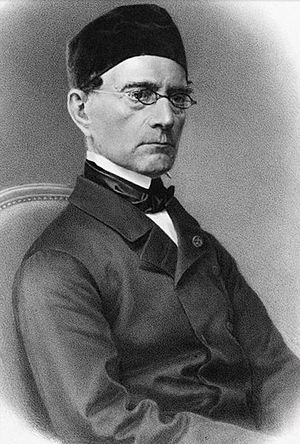Gabriel Lamé facts for kids
Quick facts for kids
Gabriel Lamé
|
|
|---|---|
 |
|
| Born | 22 July 1795 Tours, France
|
| Died | 1 May 1870 (aged 74) Paris, France
|
| Known for | Euclidean algorithm Lamé coefficients Lamé curve Lamé function Lamé parameters Lamé's special quartic |
| Scientific career | |
| Fields | Mathematics |
Gabriel Lamé (born July 22, 1795 – died May 1, 1870) was a French mathematician. He made important discoveries in how we understand shapes and how materials bend and stretch. He used special ways of describing shapes, called curvilinear coordinates, to solve tricky math problems.
Contents
About Gabriel Lamé
Gabriel Lamé was born in Tours, a city in France.
His Work with Shapes and Curves
Lamé is famous for his ideas about curvilinear coordinates. These are like a flexible grid system. Instead of straight lines, the grid uses curved lines. This helps describe complex shapes.
He also studied special curves that look like stretched ellipses. These are now called Lamé curves or superellipses. They are defined by a math equation that uses a number n. This number can be any positive real number.
Solving Problems with Algorithms
Lamé also looked at the Euclidean algorithm. This is a step-by-step method to find the largest number that divides two other numbers evenly. He studied how fast this algorithm works. This was the start of a field called computational complexity theory. This field studies how much time and effort a computer needs to solve a problem.
In 1844, Lamé used Fibonacci numbers to show something cool. He proved that the Euclidean algorithm finishes quickly. When finding the greatest common divisor of two numbers, it takes no more than 5 times the number of digits in the smaller number.
Other Math Discoveries
Lamé worked on many different math topics. He often found new math problems while working on engineering projects. For example, he studied how strong bridges and arches needed to be. This led him to learn more about how materials stretch and bend, known as elasticity theory.
He also studied how heat moves through objects. This work helped him develop his theory of curvilinear coordinates even further. These coordinates were a very useful tool for him. He used them to solve complex equations about heat and other physics problems.
One of his important contributions to engineering was understanding how parts fit together tightly. For example, how a pin fits into a hole. He could figure out the forces involved in such connections.
Later Life and Legacy
In 1854, Lamé was chosen as a foreign member of the Royal Swedish Academy of Sciences.
Gabriel Lamé passed away in Paris in 1870. His name is honored as one of the 72 names written on the Eiffel Tower in Paris.
See also
 In Spanish: Gabriel Lamé para niños
In Spanish: Gabriel Lamé para niños
- Lamé’s Theorem
- Euclidean algorithm (Algorithmic efficiency)
- Lamé crater
- Piet Hein

